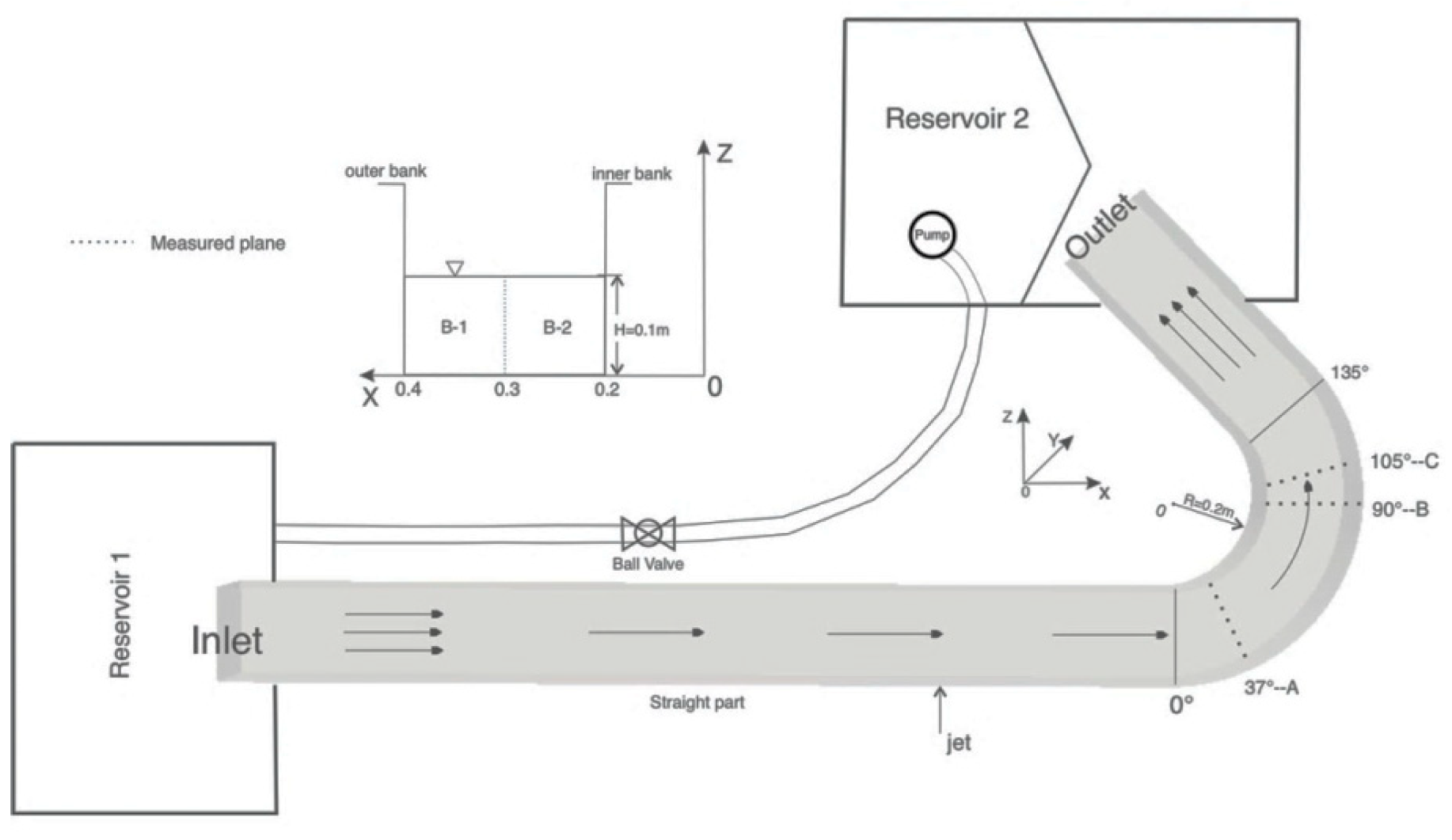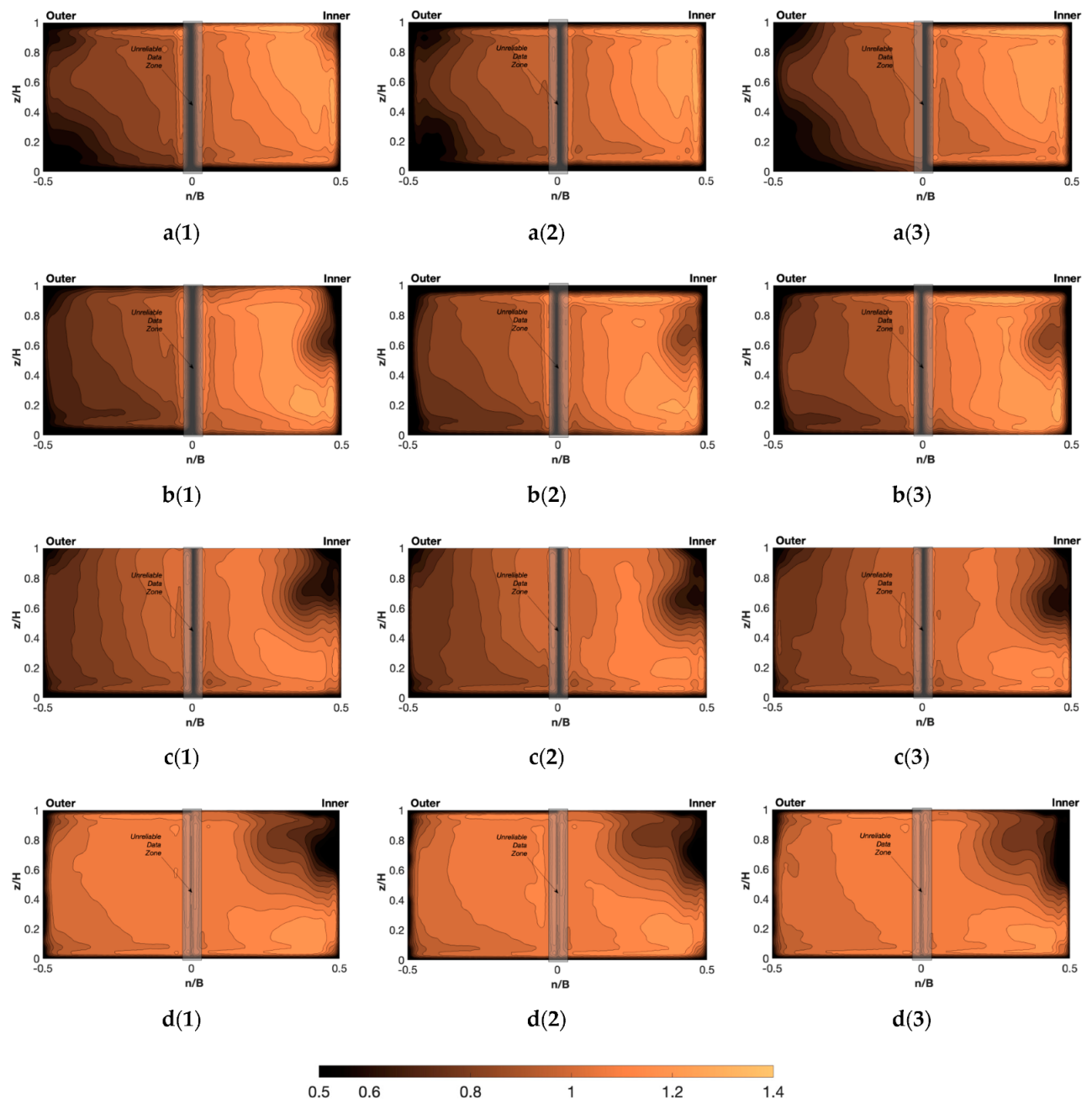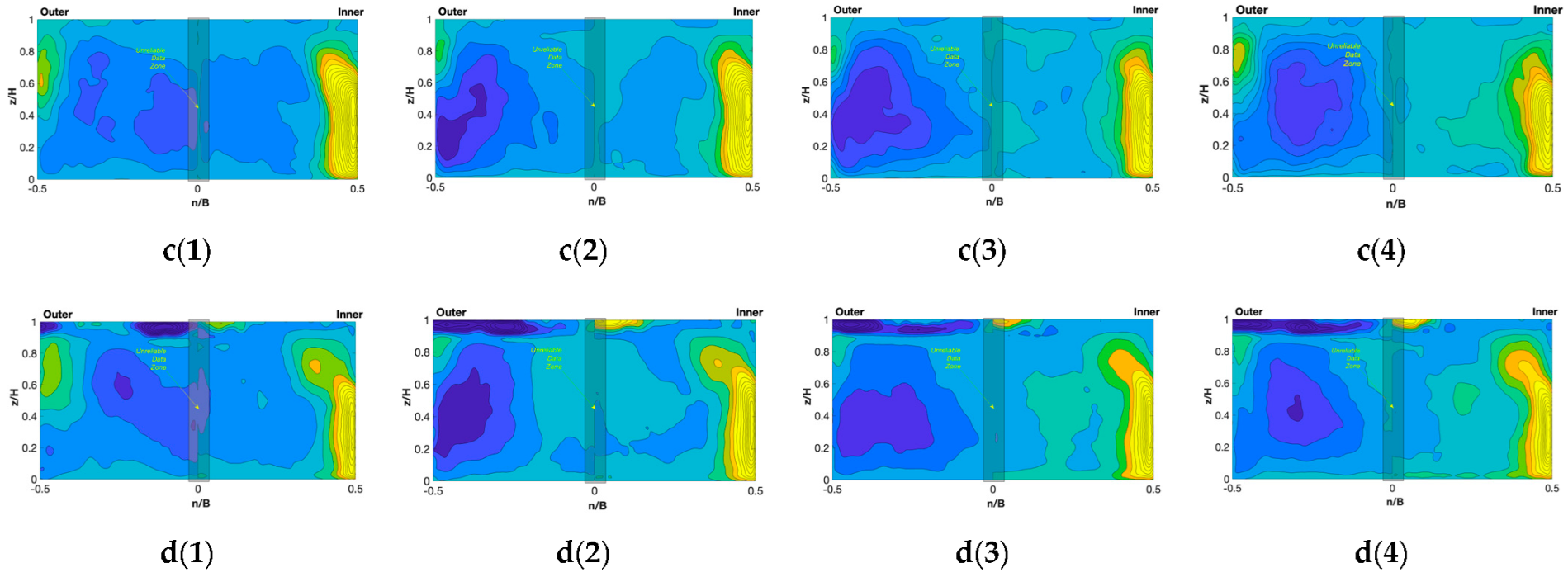Experimental Studies on the Influence of Negatively Buoyant Jets on Flow Distribution in a 135-Degree Open Channel Bend
Abstract
:1. Introduction
2. Experimental Setup and Procedures
2.1. Laboratory Flume and Flow Properties
2.2. Measurements and Procedure
2.3. Analytical Methods
3. Results and Analysis
3.1. Mean Flow Patterns and Properties
3.2. Cross-Sectional Flow Properties
3.3. Secondary Flow
4. Conclusions
Author Contributions
Funding
Data Availability Statement
Conflicts of Interest
References
- Rozovskii, I.L. Flow of Water in Bends of Open Channels; Israel Program for Scientific Translations, Translator; Academy of Sciences of the Ukrainian SSR: Kyiv, Ukraine, 1957; p. 233. (In Russian) [Google Scholar]
- Engelund, F.; Skovgaard, O. On the origin of meandering and braiding in alluvial streams. J. Fluid Mech. 1973, 57, 289–302. [Google Scholar] [CrossRef]
- Struiksma, N.; Olesen, K.W.; Flokstra, C.; De Vriend, H.J. Bed deformation in curved alluvial channels. J. Hydraul. Res. 1985, 23, 57–79. [Google Scholar] [CrossRef]
- Blanckaert, K.; De Vriend, H.J. Secondary flow in sharp open-channel bends. J. Fluid Mech. 2004, 498, 353–380. [Google Scholar] [CrossRef] [Green Version]
- Blanckaert, K.; de Vriend, H.J. Nonlinear modeling of mean flow redistribution in curved open channels: Nonlinear modeling of mean flow. Water Resour. Res. 2003, 39, 1375. [Google Scholar] [CrossRef]
- Thompson, J. On the origin of the windings of rivers in alluvial plains, with remarks on the flow of water in pipes. Royal Soc. Lond. Proc. 1876, 25, 5–8. [Google Scholar]
- Shukry, A. Flow around bends in an open flume. Trans. ASCE 1950, 115, 751–779. [Google Scholar] [CrossRef]
- Naot, D.; Rodi, W. Calculation of secondary currents in channel flow. J. Hydraul. Eng. 1982, 108, 948–968. [Google Scholar] [CrossRef]
- Odgaard, A.J.; Bergs, M.A. Flow processes in a curved alluvial channel. Water Resour. Res. 1988, 24, 45–56. [Google Scholar] [CrossRef]
- Rhoads, B.L.; Welford, M.R. Initiation of river meandering. Prog. Phys. Geogr. 1991, 15, 27–156. [Google Scholar] [CrossRef]
- Whiting, P.J.; Dietrich, W.E. Experimental studies of bed topography and flow patterns in large amplitude meanders: 1. Observations. Water Resour. Res. 1993, 9, 3605–3614. [Google Scholar] [CrossRef]
- Kawai, S.; Julien, P.Y. Point bar deposits in narrow sharp bends. J. Hydraul. Res. 1996, 34, 205–218. [Google Scholar] [CrossRef]
- Gholami, A.; Akhtari, A.A.; Minatour, Y.; Bonakdari, H.; Javadi, A.A. Experimental and numerical study on velocity fields and water surface profile in a strongly-curved 90° open channel bend. Eng. Appl. Comput. Fluid Mech. 2014, 8, 447–461. [Google Scholar] [CrossRef] [Green Version]
- Doneker, R.L.; Jirka, G.H. Expert Systems for Design and Mixing Zone Analysis of Aqueous Pollutant Discharges. J. Water Resour. Plan. Manag. 1991, 117, 679–697. [Google Scholar] [CrossRef]
- Blanckaert, K.; Graf, W.H. Experiments on flow in a strongly curved channel bend. In Proceedings of the 29th Congress-International Association for Hydraulic Research, Beijing, China, 16–21 September 2001. [Google Scholar]
- Termini, D.; Piraino, M. Experimental analysis of cross-sectional flow motion in a large amplitude meandering bend. Earth Surf. Process. Landf. 2010, 36, 244–256. [Google Scholar] [CrossRef]
- Vaghefi, M.; Akbari, M.; Fiouz, A.R. An experimental study of mean and turbulent flow in a 180-degree sharp open channel bend: Secondary flow and bed shear stress. KSCE J. Civ. Eng. 2016, 20, 1582–1593. [Google Scholar] [CrossRef]
- Wei, M.; Blanckaert, K.; Heyman, J.; Li, D.; Schleiss, A.J. A parametrical study on secondary flow in sharp open-channel bends: Experiments and theoretical modelling. J. Hydro-Environ. Res. 2016, 13, 1–13. [Google Scholar] [CrossRef]
- Blanckaert, K. Saturation of curvature-induced secondary flow, energy losses, and turbulence in sharp open channel bends: Laboratory experiments, analysis, and modeling. J. Geophys. Res. 2009, 114, F03015. [Google Scholar] [CrossRef] [Green Version]
- Kikkert, G.A.; Davidson, M.J.; Nokes, R.I. Inclined Negatively Buoyant Discharges. J. Hydraul. Eng. 2007, 133, 545–554. [Google Scholar] [CrossRef]
- Oliver, C.J.; Davidson, M.J.; Nokes, R.I. Removing the boundary influence on negatively buoyant jets. Environ. Fluid Mech. 2013, 13, 625–648. [Google Scholar] [CrossRef]
- Zhang, S.; Jiang, B.; Law, A.W.K.; Zhao, B. Large eddy simulations of 45° inclined dense jets. Environ. Fluid Mech. 2016, 16, 101–121. [Google Scholar] [CrossRef]
- Choi, K.W.; Lai Chris, C.K.; Lee Joseph, H.W. Mixing in the Intermediate Field of Dense Jets in Cross Currents. J. Hydraul. Eng. 2016, 142, 04015041. [Google Scholar] [CrossRef]
- Schreiner, H.K.; Rennie, C.D.; Mohammadian, A. Trajectory of a jet in cross-flow in a channel bend. Environ. Fluid Mech. 2018, 18, 1301–1319. [Google Scholar] [CrossRef]
- Leschziner, M.A.; Rodi, W. Calculation of strongly curved open channel flow. J. Hydraul. Div. 1979, 105, 1297–1314. [Google Scholar] [CrossRef]
- Millero, F.J.; Poisson, A. International one-atmosphere equation of state of sea water. J. Deep-Sea Res. 1981, 28, 625–629. [Google Scholar] [CrossRef]
- Prasad, A.K.; Jensen, K. Scheimpflug stereo camera for particle image velocimetry in liquid flows. Appl. Opt. 1995, 34, 7092–7099. [Google Scholar] [CrossRef]
- Graftieaux, L.; Michard, M.; Grosjean, N. Combining PIV, POD and vortex identification algorithms for the study of unsteady turbulent swirling flows. Meas. Sci. Technol. 2001, 12, 1422–1429. [Google Scholar] [CrossRef]
- Endrikat, S. Find Vortices in Velocity Fields. MATLAB Central File Exchange. Available online: https://www.mathworks.com/matlabcentral/fileexchange/52343-find-vortices-in-velocity-fields (accessed on 28 April 2022).
- Dietrich, W.E.; Whiting, P.J. Boundary shear stress and sediment transport in river meanders of sand and gravel. In River Meandering; Ikeda, S., Parker, G., Eds.; AGU: Washington DC, USA, 1989; Volume 12, pp. 1–50. [Google Scholar]
- Blanckaert, K.; Duarte, A.; Chen, Q.; Schleiss, A.J. Flow processes near smooth and rough (concave) outer banks in curved open channels. J. Geophys. Res. Earth Surf. 2012, 117, F04020. [Google Scholar] [CrossRef] [Green Version]
- Abhari, M.N.; Ghodsian, M.; Vaghefi, M.; Panahpur, N. Experimental and numerical simulation of flow in a 90 bend. Flow Meas. Instrum. 2010, 21, 292–298. [Google Scholar] [CrossRef]
- Bai, R.; Zhu, D.; Chen, H.; Li, D. Laboratory Study of Secondary Flow in an Open Channel Bend by Using PIV. Water 2019, 11, 659. [Google Scholar] [CrossRef] [Green Version]












| B (cm) | H (cm) | Rc (cm) | Q (L/s) | G (ms−2) | U (m/s) | Re | Fr |
|---|---|---|---|---|---|---|---|
| 20 | 10 | 20 | 2 | 9.8 | 0.1 | 22024 | 0.22 |
| Slice # | Sjet | Smain | Ujet (m/s) | Umain (m/s) | Ρjet (kg/m3) | Δρ | Cross-Sectional Plane (Degree) |
|---|---|---|---|---|---|---|---|
| A (1 + 2) | 3.5 | 0 | 0.2 | 0.1 | 1000 | 3 | 37 |
| 10 | 0 | 0.2 | 0.1 | 1005 | 8 | 37 | |
| 16.5 | 0 | 0.2 | 0.1 | 1010 | 13 | 37 | |
| - | 0 | - | 0.1 | - | - | 37 | |
| B (1 + 2) | 3.5 | 0 | 0.2 | 0.1 | 1000 | 3 | 90 |
| 10 | 0 | 0.2 | 0.1 | 1005 | 8 | 90 | |
| 16.5 | 0 | 0.2 | 0.1 | 1010 | 13 | 90 | |
| - | 0 | - | 0.1 | - | - | 90 | |
| C (1 + 2) | 3.5 | 0 | 0.2 | 0.1 | 1000 | 3 | 105 |
| 10 | 0 | 0.2 | 0.1 | 1005 | 8 | 105 | |
| 16.5 | 0 | 0.2 | 0.1 | 1010 | 13 | 105 | |
| - | 0 | - | 0.1 | - | - | 105 | |
| D (1 + 2) | 3.5 | 0 | 0.2 | 0.1 | 1000 | 3 | 125 |
| 10 | 0 | 0.2 | 0.1 | 1005 | 8 | 125 | |
| 16.5 | 0 | 0.2 | 0.1 | 1010 | 13 | 125 | |
| - | 0 | - | 0.1 | - | - | 125 |
Publisher’s Note: MDPI stays neutral with regard to jurisdictional claims in published maps and institutional affiliations. |
© 2022 by the authors. Licensee MDPI, Basel, Switzerland. This article is an open access article distributed under the terms and conditions of the Creative Commons Attribution (CC BY) license (https://creativecommons.org/licenses/by/4.0/).
Share and Cite
Wang, X.; Rennie, C.D.; Mohammadian, A. Experimental Studies on the Influence of Negatively Buoyant Jets on Flow Distribution in a 135-Degree Open Channel Bend. Water 2022, 14, 1898. https://doi.org/10.3390/w14121898
Wang X, Rennie CD, Mohammadian A. Experimental Studies on the Influence of Negatively Buoyant Jets on Flow Distribution in a 135-Degree Open Channel Bend. Water. 2022; 14(12):1898. https://doi.org/10.3390/w14121898
Chicago/Turabian StyleWang, Xueming, Colin D. Rennie, and Abdolmajid Mohammadian. 2022. "Experimental Studies on the Influence of Negatively Buoyant Jets on Flow Distribution in a 135-Degree Open Channel Bend" Water 14, no. 12: 1898. https://doi.org/10.3390/w14121898






